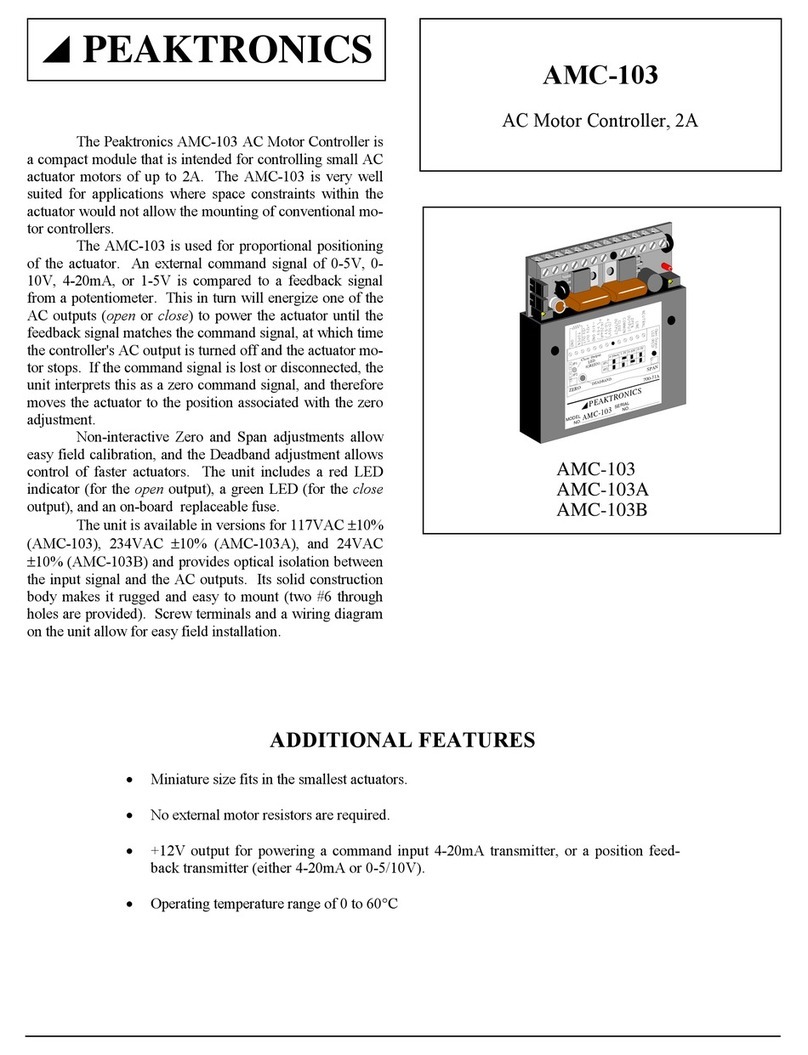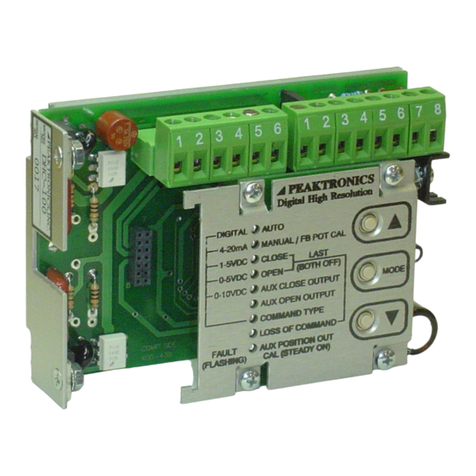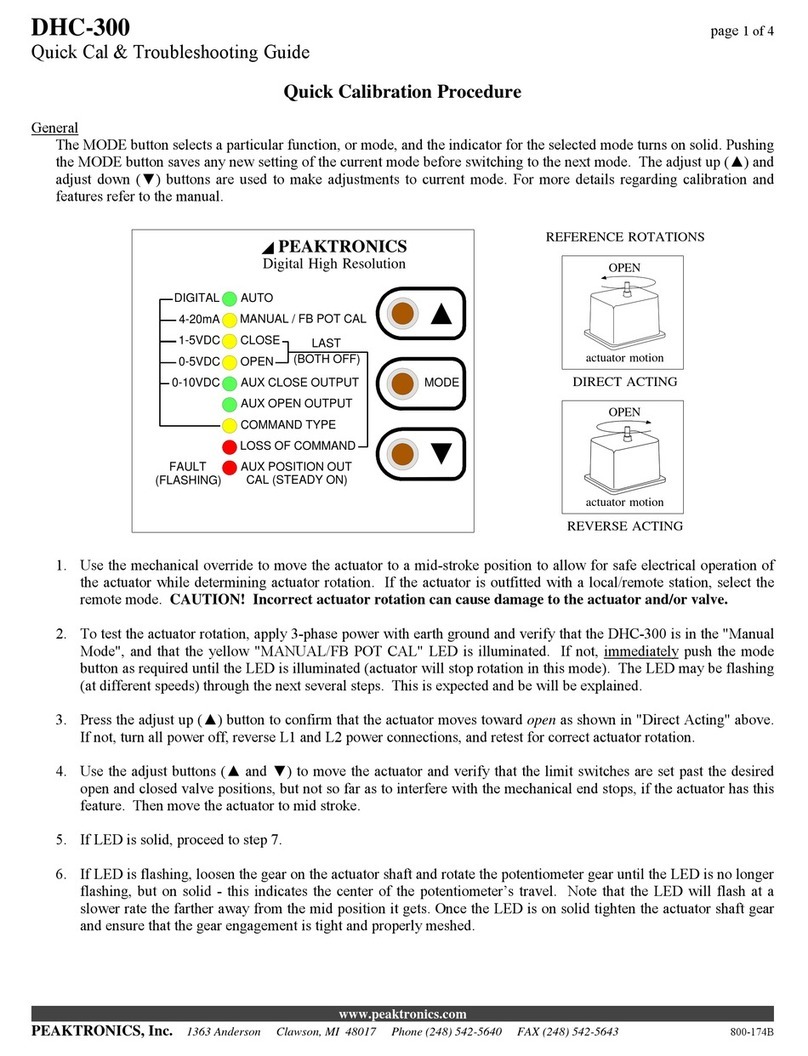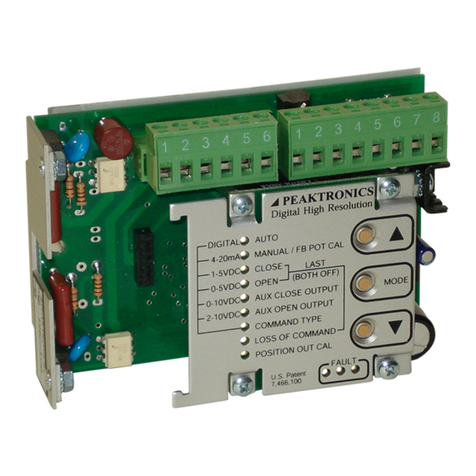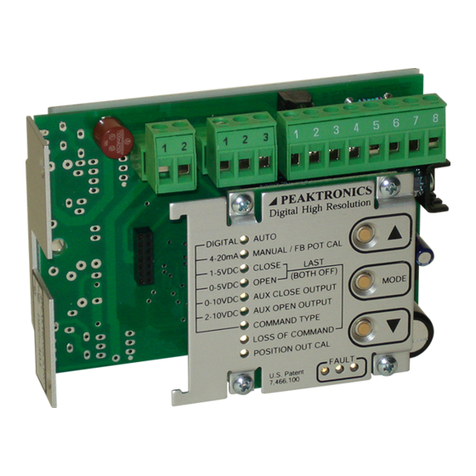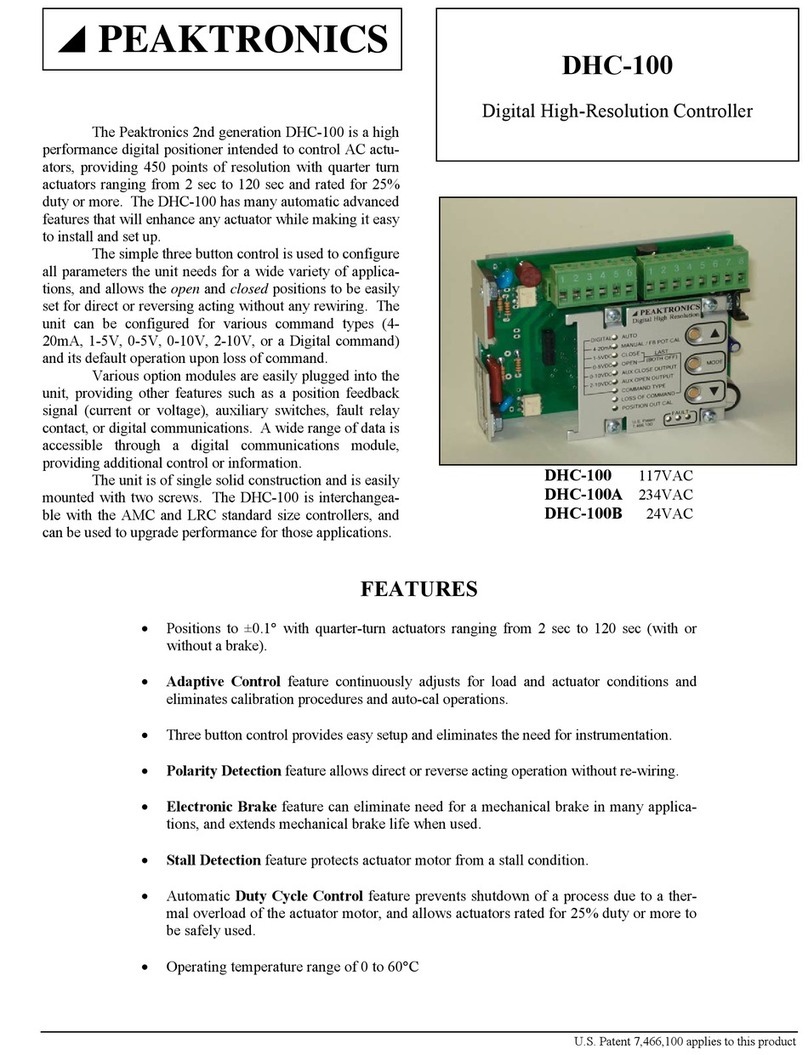
DHC-100 01-22-04 PRELIMINARY INFORMATION
6 U.S. Patent 4,803,481 applies to this product; other patents pending PEAKTRONICS
MODE button is pressed, which will also advance the unit
to the LOSS OF COMMAND function.
LOSS OF COMMAND
When using 1-5V, 4-20mA, or a Digital input type
for the command signal, the DHC-100 will detect when
the command signal is lost or out of range. A loss of com-
mand condition is detected whenever the input is discon-
nected, the input becomes less than 0.75V or 3mA, or the
input becomes greater than 5.5V or 22mA. If the DHC-
100 detects a loss of the command signal, the Fault indica-
tor will flash and the actuator will be moved to one of
three preset positions: the open position, the closed posi-
tion, or the position last attained prior to losing the com-
mand signal. The LOSS OF COMMAND function is used
to set the desired default position.
When the LOSS OF COMMAND function is se-
lected, the adjust buttons are used to set the default posi-
tion. The DHC-100 indicates the selected default setting
by flashing the Open function indicator for the open de-
fault position, or it will flash the Close function indicator
for the closed default position. When neither indicator is
on, then the "last position" default is selected.
When a 0-5V or 0-10V command signal is used, a
loss of command signal cannot be detected. Therefore, if
the unit is configured for a 0-5V or 0-10V command sig-
nal (see COMMAND INPUT), the MODE button will not
select the LOSS OF COMMAND function.
AUX POSITION OUT CAL
Note that the AUX POSITION OUT CAL indica-
tor also serves as a Fault indicator. When the indicator is
on steady, the AUX POSITION OUT CAL function is
selected. When the indicator flashes, a Fault condition has
been detected (see FAULT INDICATOR for details). The
AUX POSITION OUT CAL function is used to calibrate
an optional feedback transmitter output. An appropriate
transmitter option module is required to use this feature.
When the AUX POSITION OUT CAL function is
first selected (by pressing the MODE button while in the
LOSS OF COMMAND function), the CLOSE indicator
will flash, and the voltage or current associated with the
closed position will appear at the option module output. If
desired, the output can be adjusted (using the adjust but-
tons) to any value from 0 to 10V (for a voltage output) or
0 to 20mA (for a current output). The new setting is then
associated with the closed position.
Pressing the MODE button again will leave the
unit in the AUX POSITION OUT CAL function except
that the OPEN indicator will flash, and the output voltage
or current associated with the open position will appear at
the option module output. Like the closed setting, the out-
put can be adjusted to any voltage (from 0 to 10V) or
current (from 0 to 20mA), and the new setting is then as-
sociated with the open position.
FAULT INDICATOR
The DHC-100 detects various fault conditions that
prohibit the unit from controlling the actuator. When any
of these conditions are detected, the Fault indicator will
flash, and the motor outputs are turned off until all fault
conditions have been corrected. If an appropriate relay
option module is installed, the Fault relay output on the
option module will also turn on. A communications op-
tion module can read the specific condition(s) causing the
fault. Note that a fault condition DOES NOT disable the
motor outputs when manually controlling the actuator
with the the adjust buttons; while useful for troubleshoot-
ing, care should be excercised when operating the motor
under a fault condition. The various fault conditions are
described below:
LOSS OF COMMAND - If the command signal is dis-
connected or out of range, the fault indicator will remain
on until the signal is reconnected or back in range.
FEEDBACK POT FAULT - A fault condition is detected
whenever the feedback signal is out of range (that is, less
than 5% of the potentiometer value or more than 95% of
the potentiometer value), or when any of the potentiome-
ter connections are broken. Normal operation resumes
when the potentiometer is reconnected or back in range.
MOTOR 1 STALL - A fault condition is detected when no
actuator motion is detected while the Motor 1 output is
turn on. The fault condition will only disable the Motor 1
output, and the fault is cleared when the DHC-100 detects
a motion greater than 1.5°in either direction. The fault
can be cleared if 1) the command signal commands a Mo-
tor 2 operation, 2) manaul operation with the adjust but-
tons results in a motion greater than 1.5°, or 3) a mechani-
cal manual override forces the 1.5°motion, provided the
mechanical motion is monitored by the feedback pot.
MOTOR 2 STALL - A fault is detected when no actuator
motion is detected while the Motor 2 output is turn on.
The fault can be cleared in the same manner as a Motor 1
Stall (see above).
DOUBLE STALL - If the DHC-100 detects no actuator
motion in either direction, both motor outputs will be dis-
abled. The command signal cannot clear this condition;
